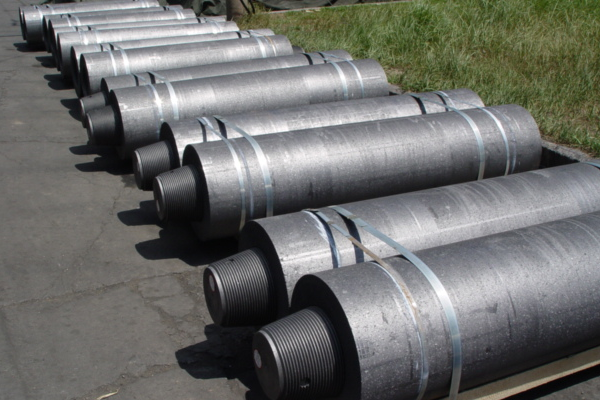

High-Power Graphite Electrodes: A Key Component in Modern Industry
Graphite electrodes are widely used in various industrial applications due to their unique properties, such as high thermal conductivity, high mechanical strength, and low electrical resistance. Among the different types of graphite electrodes, high-power graphite electrodes, with diameters ranging from 250mm to 700mm, are especially suitable for high-temperature and high-stress environments, making them an important component in modern industrial processes.
Manufacturing Process
The manufacturing process of high-power graphite electrodes typically involves the following steps:
Raw materials: The main raw materials used in the production of high-power graphite electrodes are needle coke and coal tar pitch. Needle Coke is a premium-quality petroleum coke that is used to make high-strength and high-density graphite electrodes. Coal tar pitch is a byproduct of the coal distillation process and is used as a binder to hold the needle coke particles together.
Mixing: The needle coke and coal tar pitch are mixed in a high-speed mixer to form a homogeneous paste.
Molding: The paste is then extruded through a die to form the desired shape and size of the electrode.
Baking: The molded electrode is then baked at a high temperature (typically above 1000℃) to remove impurities and convert the binder into a carbon matrix.
Graphitization: The baked electrode is then graphitized at an even higher temperature (typically above 2500℃) to improve its electrical conductivity and mechanical strength.
Applications
High-power graphite electrodes are used in a variety of industrial applications, including:
Steelmaking: The most common application of high-power graphite electrodes is in the production of steel. The electric arc furnace (EAF) process, which uses graphite electrodes to create an electric arc that melts scrap metal and other materials, is a key method for producing steel. High-power graphite electrodes are particularly well-suited for this process due to their ability to withstand the high temperatures and mechanical stresses involved.
Aluminum Production: High-power graphite electrodes are also used in the production of aluminum. In this process, graphite electrodes are used to create an electric current that passes through a bath of molten aluminum oxide, which then reduces the oxide to produce aluminum metal. High-power graphite electrodes are again preferred due to their ability to withstand the high temperatures and stresses involved.
Silicon Production: High-power graphite electrodes are used in the production of silicon, which is an essential component in many electronic devices. In this process, the electrodes are used to heat a mixture of silicon dioxide and carbon, which then reacts to form silicon and carbon monoxide. High-power graphite electrodes are preferred due to their ability to withstand the high temperatures and corrosive environment involved.
Other Metallurgical Processes: Graphite electrodes are used in many other metallurgical processes, including the production of copper, nickel, and zinc. They are also used in the production of other metal and non-metal materials, such as tungsten, graphite, and alumina.
Carbon Industry: Graphite electrodes are also used in the carbon industry, including the processes of graphitization and carbonization.
Other Applications: High-power graphite electrodes are also used in other applications, such as glass, ceramics, and refining.
Conclusion
High-power graphite electrodes are an essential component of modern industry. Their unique properties, including high thermal conductivity, high mechanical strength, and low electrical resistance, make them suitable for a wide range of high-temperature and high-stress environments. The manufacturing process involves combining needle coke and coal tar pitch, extruding and baking the molded electrode, and graphitizing it to improve its electrical conductivity and mechanical strength. High-power graphite electrodes are used in a variety of industrial applications, including steelmaking, aluminum production, silicon production, and other metallurgical processes. They are also used in the carbon industry, as well as in other applications such as glass, ceramics, and refining.
However, the production of high-power graphite electrodes can be challenging due to the high-quality requirements and the limited availability of needle coke. As a result, the cost of high-power graphite electrodes is relatively high compared to other types of graphite electrodes.
To address these challenges, researchers and manufacturers are exploring new materials and production methods to reduce costs and improve the performance of high-power graphite electrodes. For example, some companies are developing new forms of carbon materials, such as graphene, that could potentially replace needle coke in the production of graphite electrodes. Other researchers are investigating the use of 3D printing and other advanced manufacturing techniques to produce electrodes with more complex shapes and structures.
In addition to these technological advancements, there is also a growing emphasis on sustainability and environmental responsibility in the production of high-power graphite electrodes. Many manufacturers are implementing measures to reduce their carbon footprint and minimize waste and pollution in their production processes.
In conclusion, high-power graphite electrodes are a critical component in modern industrial processes. Their unique properties make them suitable for a wide range of high-temperature and high-stress environments, and they are used in a variety of applications across different industries. While the production of high-power graphite electrodes can be challenging and costly, ongoing research and development efforts are focused on improving their performance and sustainability, which will further support their use in modern industry.
